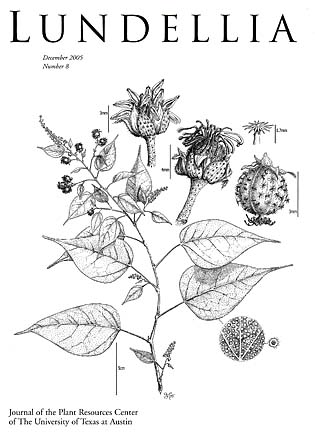
Journal of the Plant Resources Center of the University of Texas at Austin
Number 8 — December 2005
[Published: 7 November 2005]
Contents:
Taxonomy and Identification of
Isoetes (Isoetaceae) in Texas Based on Megaspore Features.
Walter C. Holmes, Ann E. Rushing, and Jason R. Singhurst
View Abstract
A Revision of the
Teucrium cubense (Lamiaceae) Complex.
B. L. Turner
View Abstract
A New Mexican Species of
Croton section
Eluteria (Euphorbiaceae).
Grady L. Webster
View Abstract
Two New Species of
Polygala (Polygalaceae) from Western Mexico.
Tom Wendt
View Abstract
Taxonomy of
Hymenoxys subgenus
Rydbergia (Asteraceae: Helenieae: Tetraneurinae).
Mark W. Bierner
View Abstract
Abstracts
Taxonomy and Identification of Isoetes (Isoetaceae) in Texas Based on Megaspore Features.
Walter C. Holmes, Ann E. Rushing, and Jason R. Singhurst
1—6
Abstract: Scanning electron microscopy examination of Texas specimens of Isoetes revealed differences in megaspore ornamentation patterns of the proximal and distal surfaces that support the recognition of four species of the genus in Texas. These include I. butleri and I. melanopoda, both of widespread occurrence in the central United States, I. lithophila, a central Texas endemic, and I. piedmontana, which we report as new to the state. A key to species based upon megaspore characteristics, distributions, a limited list of exsiccatae, and descriptions and micrographs of megaspores are included.
Return to Vol. 8 Contents
A Revision of the Teucrium cubense (Lamiaceae) Complex.
B. L. Turner
7—11
Abstract: In 1946 the Teucrium cubense complex was treated as having four subspecies by McClintock and Epling. In the present account these have been treated as distinct species: Teucrium cordobense, T. cubense, T. depressum, and T. laevigatum. An additional species, T. coahuilanum is described from north-central Mexico, this previously recognized as a North American populational element of T. laevigatum.
Return to Vol. 8 Contents
A New Mexican Species of Croton section Eluteria (Euphorbiaceae).
Grady L. Webster
12—16
Abstract: A new species of Croton sect. Eluteria from Estado de Veracruz, Mexico, Croton gomezii, is described and illustrated. The species appears most closely related to Croton arboreus on the basis of its indumentum, but has been generally confused with Croton reflexifolius. A key is provided to aid in distinguishing Croton gomezii from related Mexican species of section Eluteria.
Return to Vol. 8 Contents
Two New Species of Polygala (Polygalaceae) from Western Mexico.
Tom Wendt
17—27
Abstract: Two new species of Polygala subgenus Polygala (Polygalaceae) are described from western Mexico. Polygala mcvaughii is related to P. subalata, from which it differs by its shorter, broader racemes, longer pedicels, and always annual habit, and to P. conferta, differing from that species by its larger seeds and larger, usually ± non-stipitate fruits. It is known from 1200-2250 m in Michoacán, Jalisco, Aguascalientes, and extreme southern Zacatecas. Polygala tellezii belongs to a group of species in which a reduced or no aril and short seed hairs are the norm, and in which a vegetative vestiture of minute capitate hairs is common. This new species is in some ways morphologically most similar to the South American P. exigua, but it is perhaps most closely related to the sympatric P. glochidiata, from which it differs in its entirely alternate leaves and non-uncinate seed hairs. Polygala tellezii is known only from three localities in lowland savannas in southern Nayarit.
Resumen: Se describen dos especies de Polygala subgénero Polygala (Polygalaceae) del oeste de México como nuevas para la ciencia. Polygala mcvaughii está relacionada con P. subalata, pero difiere de esta especie en los racimos más cortos y más anchos, los pedicelos más largos, y el hábito siempre anual; y a P. conferta, de la cual difiere en sus semillas más grandes y sus frutos más grandes y normalmente ± sin estípite. Ha sido recolectada de los 1200-2250 m.s.n.m. en Michoacán, Jalisco, Aguascalientes, y el extremo sur de Zacatecas. Polygala tellezii pertenece a un grupo de especies que generalmente presentan un arilo muy pequeño o ausente y los pelos de las semillas cortos; en este grupo, los pelos capitados diminutos son característicos de muchas especies, pero no todas. La especie nueva se asemeja a la especie sudamericana P. exigua en algunos aspectos de su morfología, pero es más probable que esté más cercanamente emparentada a la especie simpátrica P. glochidiata, de la cual difiere en sus hojas completamente alternas y los pelos no uncinados de las semillas. Polygala tellezii se conoce solamente de tres localidades en sabanas de tierras bajas en el centro y sur de Nayarit.
Return to Vol. 8 Contents
Taxonomy of Hymenoxys subgenus Rydbergia (Asteraceae: Helenieae: Tetraneurinae).
Mark W. Bierner
28—37
Abstract: Hymenoxys subg. Rydbergia comprises H. brandegeei, H. grandiflora, and H. insignis. The treatment includes a discussion of the original circumscription of the taxa, the description of the genus Rydbergia to accommodate H. brandegeei and H. grandiflora, the eventual placement of Rydbergia within Hymenoxys as a subgenus, and relationships of the three taxa to one another and to other taxa of Hymenoxys. The treatment also includes synonymies, descriptions, and range maps for each of the species, and lectotypification of Actinella brandegeei.
Resumen: Hymenoxys subg. Rydbergia incluye H. brandegeei, H. grandiflora, y H. insignis. El tratamiento incluye una discusión de la circumscripción original de los taxones, la descripción del género Rydbergia para acomodar H. brandegeei y H. grandiflora, la colocación eventual de Rydbergia en Hymenoxys como un subgénero, y las relaciones filogenéticas de los tres taxones entre ellos y la de éstos con los otros taxones de Hymenoxys. El tratamiento incluye también sinonímias, descripciones, mapas de distribución para cada una de las especies, y lectotipificación de Actinella brandegeei.
Return to Vol. 8 Contents
 Lundellia Home Page
Lundellia Home Page
U. Texas at Austin | Plant Resources Center | Contact Us